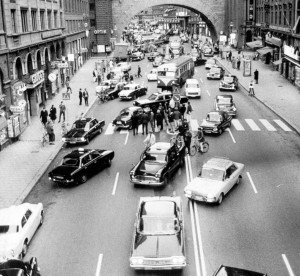For the past few days, I’ve been thinking about something I spotted on The Atlantic Monthly’s website. It’s called, “The Case Against Cars In 1 Utterly Entrancing GIF.” You can take a look at it here.
Basically, the animation shows a street full of cars, flashing to their drivers seated on the road. Then those people are grouped, and loaded onto a streetcar. The point of the GIF is to show how public transit reduces congestion.
Since Curbing Cars launched this summer, I’ve been struck by the polarization in the discussion over transportation use. At one end are people who think cars are evil and to be avoided at all costs. At the other end are those who love automobiles and think the people who despise them are crazy.
There’s very little discussion about the middle ground, which is where I think many Americans are heading, and will be heading in the next few years. That is, cars as part of a mix of personal transportation, but not the only option. It’s what the Livable Streets Coalition calls “driving light,” and which others call “living car light.”
That seems to make perfect sense, and yet, as with many moderate points of view, that thought seems to be getting overlooked. Here at Curbing Cars, we’re not anti-car. We don’t expect North Americans to suddenly screech their car use to a complete halt, and abandon them as if they are characters in one of those apocalyptic movies.
Instead, we’re studying and reporting on what seems to be a trend of trying other options along with cars. I really can’t stress that enough. It simply isn’t practical for many people to give up cars completely. I often transport elderly relatives, and I just wouldn’t be able to do that on my Schwinn.
But I can walk up the corner and ride a bus downtown. I can maneuver my bike through side streets to the Farmer’s Market. There are two grocery stores a 10 minute walk from my house.
As an experiment, I’ve been logging the number of miles I drive in a typical week. I work from home, and I drive some longer distances on assignment or to see friends. But so far this week, just around Ann Arbor, I’ve driven exactly nine miles. The amount of time I spend in my car just gets shorter and shorter.
In Los Angeles, as I write this, the auto industry is gathered for that city’s annual auto show. It’s always been the spot where carmakers talk about their fuel efficient vehicles.
This week, some of that spotlight has been stolen by the latest controversy involving Elon Musk and Tesla Motors. The federal government is going to investigate a handful of fires in Tesla Model S cars, even though Musk said there “absolutely” would not be a recall.
Musk, who is a master of publicity, is upset with the publicity that the fires have generated. He thinks the media is overplaying the situation. Of course, you didn’t hear a peep out of him as Tesla stock was vaulting to record levels over the summer.
Meanwhile, the car companies are finding they have some competition brewing from Google, which let The New Yorker into its automobile design studio, home of its self-driving car. (I asked to see it when I was at Stanford last fall, and Google did not respond to my request to visit.)
You couldn’t blame the car people if they feel like society is turning on them. Of course, it isn’t, nor are we.
But things are changing, and I’m willing to bet that when the LA auto show takes place five years from now, there will be a very different transportation landscape.
It doesn’t require getting rid of all the cars. But they won’t be the only way to get around.

